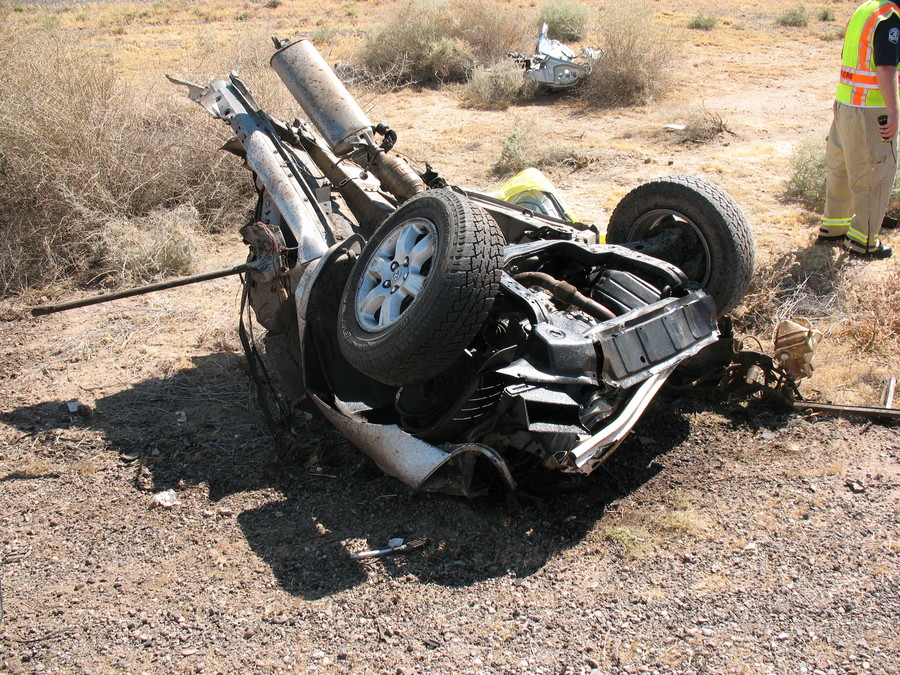It was mid-morning just south of the Valley, when Pamela Humphrey lost control of her SUV after swerving to miss something on Interstate 10.
Her vehicle skidded then rolled across the dirt median into oncoming traffic before hitting a semi-truck head-on.
The wreckage left little doubt about whether Humphrey, or her fellow passenger and sister-in-law, Ann Quinn, survived the crossover crash.
“What happened to her car is like, exploded. I wasn’t able to recognize her body,” said Mike Humphrey, Pam’s husband. “This is what happens when two cars hit each other at 75 mph.”

The crash happened at milepost 171 on May 14, 2008.
Ever since, Mike Humphrey has been locked in a lengthy and costly legal battle with the Arizona Department of Transportation to place cable median barriers on Interstate 10 between Phoenix and Tucson to prevent future crossover crashes.
Cable median barriers are high-tension wires strung along a series of posts.
Studies show they are highly effective at preventing crossover incidents and have significantly decreased fatalities in other states.
But on Interstate 10, from the south tip of the Valley to Tucson, there are roughly 60 miles of road without any raised barrier separating the eastbound and westbound lanes.
“They just have to have these cables,” Humphrey said. “If a cable barrier was there, (his wife) would have hit the cable and she would have stopped…There needs to be pressure put on this agency to put the cables in.”
But Arizona Department of Transportation officials said that’s not going to happen; and a string of expensive jury verdicts against the state aren’t changing their minds.
“By putting up cable barriers we would be causing more harm than good,” said Steven Boschen, an assistant director with ADOT. “If we put a barrier out there, we are just introducing more harm. A barrier is actually a hazard and there would be more crashes.”
Boschen said most dirt medians on Interstate 10 are roughly 80 feet and that “very wide” separation is the “best design out there.”
He also said crossover crashes, in general, are very rare and account for one percent of the state’s fatal crashes.
“We don’t want to practice shotgun engineering,” Boschen said. “What I mean by that is, if there is a crash, we don’t want to immediately go out there and say there is a problem. We need to do a safety analysis out there. Interstate 10 is very straight and there’s really no deficiencies out there.”
But ADOT has only tracked crossover incidents since 2015.
It’s the same year Mike Humphrey’s case went to trial and the verdict was one of the largest in Arizona history: a $40 million judgment against the state.
The jury believed that ADOT should have had cables along the stretch of I-10 and was negligent. The decision was based – at least in part – by evidence from Humphrey’s legal team that showed Interstate 10 has had a history of crossover crashes.
Mike Humphrey and his legal team provided ABC15 with Arizona crash reports detailing crossover crashes on two stretches of Interstate 10 from 2001 to 2014. ADOT also provided ABC15 with the crossover figures it’s collected in the past three years.
Humphrey believes those reports show crossover crashes are common and dangerous.
Since 2001, within the 20-mile stretch (mileposts 160 to 180) where Humphrey’s family died, there were at least 64 crossover crashes that injured 74 and killed 20. In another 20-mile stretch near Picacho Peak, there were at least 81 crashes that injured 79 and killed 26.
Given the volume of traffic on Interstate 10 and the time frame, ADOT believes those crashes are disparate and unpredictable.
“We have looked at that data and have not seen any clusters. These are extremely rare, unpredictable events,” Boschen said. When asked what would constitute a cluster, he said, “A cluster might be five that happened in a one-mile area in a year.”
The massive verdict in the Humphrey case was on top of another $8 million decision against the state for a crossover crash that happened within the same year and mile of the Humphrey crash. That’s two similar crashes on Interstate 10 totaling nearly $50 million in verdicts against the state.
To cable the entire stretch of Interstate 10 between Phoenix and Tucson would cost $12 million.
Humphrey said he never wanted this to go to trial. He said it was always about the cables.
“Heck, at one point I offered to settle the whole thing for a mile of cable,” Humphrey said. “Just put in a mile of cable.”
Arizona administration officials didn’t respond to a request for comment about Humphrey’s settlement offer.
But ADOT officials said costs aren’t the deciding factor.
“The best design that’s out there is the design we have out there,” said Boschen, referring to the 80-foot dirt medians. He said ADOT has no plans to add median barriers any time soon.
“Neither on this section or other interstates do we think that is the best option,” Boschen said.
But Humphrey isn’t going away and has vowed to keep fighting in memory of his lost wife and sister.
“Not being able to be with your loved one at the end is just devastating,” Humphrey said. “It didn’t have to happen. It’s just so soul-crushing knowing there’s something that could be done and she’d be with me.”
Contact ABC15 Investigator Dave Biscobing at dbiscobing@abc15.com.


